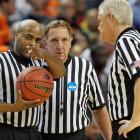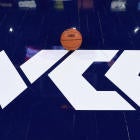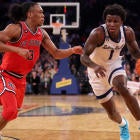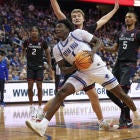College basketball's on-court product has undeniably gotten better in the past two seasons thanks to progressive, if not drastic, changes to its rulebook.
But on Friday, the NCAA released its latest slate of suggestions from the Men's Basketball Rules Committee -- and the proposals put forth are relatively tepid. So what's the reason for the resistance to more change? The three items that were key talking points in recent months -- extending the 3-point line, going to quarters instead of halves, widening the lane -- are all missing from the proposal list.
"The game is headed back in the right direction," Duquesne coach/committee chair Keith Dambrot said on a conference call. "We want to make sure any changes we do make don't affect that trend. We also rely heavily on the (annual) rules survey that's sent out to (coaches, commissioners, media, officials), and there wasn't a huge push to make big changes at this time."
The Rules Committee is satisfied with the evolution of the game and doesn't want to go overboard in its decisions, essentially. College basketball is up more than six points per team per game in the past two years (that's great progress), and that has not been a byproduct of a drastic uptick in fouls, either.
"This year's point total and field goal percentage (44.4 percent) are the highest since the 1994-95 season," per the NCAA. "Teams also averaged 70.3 possessions per game in the 2016-17 season compared with 65.8 two years ago. Divisions II and III schools showed similar statistics in the past two seasons."
The game has more consistent flow, is more watchable and the consensus is that the sport is in a better spot now than it was -- from a gameplay perspective -- in the 2010-15 era.
But it's important to know that extending the 3-point shot (the FIBA distance and the NBA distance are the two in debate), going to quarters and widening the lane are all still on the table. Specifically, Dambrot and secretary-rules editor Art Hyland said that more data is needed on making these kind of big-headline, wholesale changes before they can be passed.
In a step toward moving to four quarters, the NIT experimented with the 1-and-1 concept and resetting team fouls at the 10-minute mark of each half during its most recent tournament, but that data set alone wasn't enough to suffice for the Rules Committee to put forth actual change. Plus, there are television contracts regarding commercial breaks and big-time monetary negotiations that need to be aligned in conjunction with a major tweak such as that.
If change is to come, the power is partly in the hands of the conferences. The Rules Committee and the NCAA are encouraging leagues to "experiment" with any and all of these potential rule changes (like pushing the 3-point line back) in an effort to get more data. If any leagues opt to do this, the experimentation would only be done during intra-conference competition.
Here are the rule proposals on the table. To me, resetting the shot clock is the biggest of the lot, and also a no-brainer. This will continue to bring more possessions into the game and up scoring. These eight recommendations will go to a vote on June 13.
- Extend the coach's box to 38 feet from 28 feet to better coaches' communication when their team is at the other end of the floor.
- The shot clock resets to 20 seconds, not 30, when the ball is inbounded in the front court after a foul or any othr violation by the defense. If more than 20 seconds remain, the clock does not drop to 20.
- Front court throw-ins will be more consistent, meaning they'll either be 28 feet from the corner or three feet outside of the lane, on the baseline, depending on where the ball goes out of bounds. Deflections will still be inbounded where the ball went out.
- Instant replay will be allowed in the final two minutes of regulation and overtime to determine if a secondary defender was in or out of the semi-circle. If the secondary player is in, it's a block. If the player is out, it's a charge.
- Any time the ball is touched, 0.3 seconds will be taken off the clock.
- Legal screens now require that the inside of a player's feet, the one doing the screening, can't be wider than his shoulders.
- This one's a mouthful: "Adjust the officiating guidance in relation to the cylinder rule. If a defensive player straddles an offensive player's leg in a way that prohibits him from making a normal basketball move — which now includes pivoting — contact that creates a common foul will be called on the defensive player."
- Lastly, there will be off-site reviews done to assist and/or collaborate with game officials, in the event a second set of eyes is needed to get a call right in the closing minutes. This request came from the SEC.
There are those who think college basketball should entirely adopt NBA and/or FIBA legislation, but the reality is that's not going to happen.
"We feel like the college game should be a unique game still, and not mirrored after the NBA" Dambrot said.
There is something positive to be said for the college game's identity. It should never and will never be exactly as the same as the NBA, and with good reason. But Hyland was sure to note that the NBA is eager to work with the NCAA to pass along its own data and research, particularly how shooters took time to adjust when the NBA pushed its 3-point line back in the late 1990s. The NCAA is open to this kind of collaboration, too.
If the 3-point line or widening of the lane is coming to college basketball in the next couple of years, the NBA's assistance on this matter will probably wind up being key. But in the short-term, college hoops won't see any major adjustments, and given the way the sport has adapted in the past two years, that's certainly OK.





















